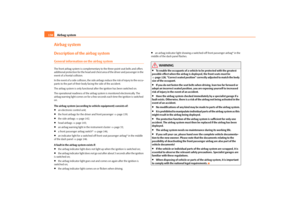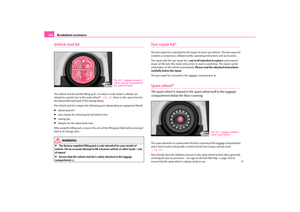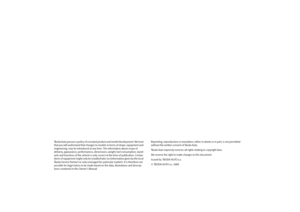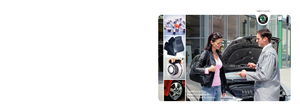Page 137 of 259

Seat belts 136Taking seat belts off– Press the red button in the belt lock ⇒fig. 148. The spring force causes
the tongue of the lock to jump out.
– Guide the belt back with your hand to enable the inertia reel to wind
up the belt webbing more easily.A plastic knob in the belt webbing holds the belt tongue in a position which is easy
to get hold of.Three-point safety belt for the middle rear seatIt is used in the same way as the normal three-point seat belts on the left and right
(at front and rear). The three-point seat belt for the rear middle seat must be put on
first to allow the pelvic part of the belt to run between the belt lock for the right
three-point seat belt and the backrest, while avoiding crossing the belt webbing of
the right and middle seat belts.
WARNING
•
The three-point safety belt for the rear middle seat can only fulfil its func-
tion reliably when the backrests are correctly locked into position
⇒page 65.
Note
The vehicles of the group N1 are not equipped with the third seat belt on the rear
seats. The vehicle is only approved for four persons.Belt tensionerSafety for the driver and front passenger wearing their seat belts is enhanced by
the belt tensioners fitted to the inertia reels of the front three-point seat belts.
The fastened three-point seat belts are automatically tensioned in the event of a
frontal collision of a certain severity. The belts tensioners are also deployed if the
seat belts are not fastened.
Belt tensioners are not activated in the event of minor frontal collisions, side and
rear-end collisions, in the case of a rollover and also not in accidents in which no
major forces are produced from the front.
WARNING
•
Any work on the belt tightener system, including removal and installa-
tion of system components because of other repair work, must only be
carried out by a specialist garage.
•
The protective function of the system is only adequate for a single acci-
dent. If the belt tensioners have been deployed, it is then necessary to
replace the entire system.
•
The Owner's Manual must also be handed over to the new owner if the
vehicle is sold.Note
•
Smoke is generated when the belt tensioners are deployed. This is not an indi-
cation of a fire in the vehicle.
•
It is essential to pay attention to relevant safety regulations if the vehicle or indi-
vidual parts of the system are scrapped. Specialist garages are familiar with these
regulations and will be able to provide you with detailed information in this respect.
Fig. 148 Releasing lock
tongue from belt lock
s3f4.1.book Page 136 Thursday, June 18, 2009 11:07 AM
Page 138 of 259
Seat belts137
Using the system
Safety
Driving Tips
General Maintenance
Breakdown assistance
Technical Data
•
When disposing of vehicle or parts of the system, it is important to comply with
the national legal requirements.
s3f4.1.book Page 137 Thursday, June 18, 2009 11:07 AM
Page 139 of 259

Airbag system 138Airbag systemDescription of the airbag systemGeneral information on the airbag systemThe front airbag system is complementary to the three-point seat belts and offers
additional protection for the head and chest area of the driver and passenger in the
event of a frontal collision.
In the event of a side collision, the side airbags reduce the risk of injury to the occu-
pants to the part of their body facing the side of the accident.
The airbag system is only functional after the ignition has been switched on.
The operational readiness of the airbag system is monitored electronically. The
airbag warning light comes on for a few seconds each time the ignition is switched
on.
The airbag system (according to vehicle equipment) consists of:•
an electronic control unit;
•
the front airbags for the driver and front passenger ⇒page 139;
•
the side airbags ⇒page 142;
•
head airbags ⇒page 143;
•
an airbag warning light in the instrument cluster ⇒page 33;
•
a front passenger airbag switch* ⇒page 146;
•
an indicator light for a switched off front seat passenger airbag* in the middle
of the dash panel ⇒page 146.
A fault in the airbag system exists if:
•
the airbag indicator light does not light up when the ignition is switched on;
•
the airbag indicator light does not go out after about 3 seconds after the ignition
is switched on;
•
the airbag indicator light goes out and comes on again after the ignition is
switched on;
•
the airbag indicator light comes on or flickers when driving;
•
an airbag indicator light showing a switched-off front passenger airbag* in the
middle of the dash panel flashes.
WARNING
•
To enable the occupants of a vehicle to be protected with the greatest
possible effect when the airbag is deployed, the front seats must be
⇒page 128, “Correct seated position” correctly adjusted to match the body
size of the occupant.
•
If you do not fasten the seat belts when driving, lean too far forward or
adopt an incorrect seated position, you are exposing yourself to increased
risk of injury in the event of an accident.
•
Have the airbag system checked immediately by a specialist garage if a
fault exists. Otherwise, there is a risk of the airbag not being activated in the
event of an accident.
•
No modifications of any kind may be made to parts of the airbag system.
•
It is prohibited to manipulate individual parts of the airbag system as this
might result in the airbag being deployed.
•
The protective function of the airbag system is sufficient for only one
accident. The airbag system must then be replaced if the airbag has been
deployed.
•
The airbag system needs no maintenance during its working life.
•
If you sell your car, please hand over the complete vehicle documenta-
tion to the new owener. Please note that the documents relating to the
possibility of deactivating the front passenger airbag are also part of the
vehicle documents!
•
If the vehicle or individual parts of the airbag system are scrapped, it is
essential to observe the relevant safety precautions. Specialist garages are
familiar with these regulations.
•
When disposing of vehicle or parts of the airbag system, it is important
to comply with the national legal requirements.
s3f4.1.book Page 138 Thursday, June 18, 2009 11:07 AM
Page 140 of 259

Airbag system139
Using the system
Safety
Driving Tips
General Maintenance
Breakdown assistance
Technical Data
When are the airbags deployed?The airbag system is designed in such a way that the driver and the front passenger
airbag* are deployed in the event of a frontal collision of major severity.
In the case of a violent side crash, the side airbag* in the front seat and the head
airbag* on the side on which the collision occurs are deployed.
It is also possible under certain special accident situations that the front as well as
the side airbags and head airbags* are deployed at the same time.
The airbags are not deployed in the case of minor frontal and side collisions, in the
case of rear-end collisions and vehicle rollover.
Deployment factors
It is not possible to state globally which deployment conditions apply to the airbag
system in every situation as the circumstances which exist in the case of accidents
vary greatly. An important role in this case, for example, is played by factors such as
the type of object against which the vehicle impacts (hard, soft), the angle of impact,
the vehicle speed etc.
A decisive factor for the deployment of the airbags is the deceleration which occurs
during a collision. The control unit analyses the nature of the collision and activates
the relevant restraint system. If the vehicle deceleration which occurs and is meas-
ured during the collision remains below the prescribed reference values specified
in the control unit, the airbags are not deployed although the vehicle may well
suffer severe damage to the bodywork as a consequence of the accident.
The airbags are not deployed if:•
ignition is switched off;
•
a minor frontal collision;
•
a minor side collision;
•
a rear-end collision;
•
Rollover of the vehicle.Note
•
A grey white or red, non harmful gas is released when airbag is inflated. This is
perfectly normal and is not an indication of a fire in the vehicle.
•
In the event of an accident in which the airbags are deployed:
−the interior lighting comes on (if the switch for the interior light is in the door
contact position),
−the hazard warning light is switched on;
−All the doors are unlocked.
Front airbagsDescription of the front airbags
The airbag system is not a substitute for the seat belt!
Fig. 149 Driver airbag in the
steering wheelFig. 150 Front passenger
airbag in the dash panel
s3f4.1.book Page 139 Thursday, June 18, 2009 11:07 AM
Page 141 of 259

Airbag system 140The front airbag for the driver is housed in the steering wheel ⇒page 139, fig. 149.
The front airbag for the front passenger* is housed in the dash panel above the
storage compartment ⇒page 139, fig. 150. The installation positions are each
marked with the “AIRBAG” logo.
The front airbag system, in combination with three-point safety belts, offers addi-
tional protection for the head and chest area of the driver and front passenger in
the event of a frontal collision of major severity ⇒ in “Important safety informa-
tion regarding the front airbag system” on page 141.
The airbag is not a substitute for the seat belt, but is part of the complete passive
vehicle safety concept. Please note that an airbag can only offer you optimal
protection in combination with a seat belt which is fastened.
Apart from their normal protective function, a further task of the seat belts is to
also hold the driver and front passenger in a correct seated position in the event of
a frontal collision so as to enable the front airbags to offer the maximum protection.
You should therefore always fasten the seat belts, not only because this is required
by law, but also for safety reasons and for your own protection ⇒page 132, “Why
seat belts?”.
Caution
The dash panel must be replaced after the front passenger airbag has been
deployed.
Function of the front airbags
Risk of injury to the upper part of the body is reduced by fully inflated
side airbags.The airbag system is designed in such a way that the driver and front passenger
airbag* are deployed in the event of a frontal collision of major severity.
In certain accident situations, the front, side and head airbag are simultaneously
deployed.
If the airbags are deployed, the airbags are filled with a propellant gas and inflated
in front of the driver and front passenger ⇒fig. 151. The airbags inflate in fractions
of a second and at a high speed in order to be able to offer that additional protec-
tion in the event of an accident. The movement of the driver and of the front
passenger is cushioned when they make contact with the fully inflated airbag and
the risk of injury to head and chest is thus reduced.
The specially developed airbag allows the gas to flow out of the inflated airbag in a
controlled manner (depending on the load of the particular car occupant) in order
to cushion head and chest areas. The airbag then deflates subsequently to such an
extent, after an accident, to again provide a clear view forward.
A grey white, non harmful gas is released when airbag is inflated. This is perfectly
normal and is not an indication of a fire in the vehicle.
Fig. 151 Inflated airbags
s3f4.1.book Page 140 Thursday, June 18, 2009 11:07 AM
Page 142 of 259

Airbag system141
Using the system
Safety
Driving Tips
General Maintenance
Breakdown assistance
Technical Data The airbag develops enormous forces when triggered, which can lead to injuries if
the sitting position or seated position is not correct ⇒ in “Important safety
information regarding the front airbag system” on page 141.
Important safety information regarding the front airbag system
Correct use of the airbag system considerably reduces the risk of
injury!
WARNING
•
Never transport children on the front seat of a vehicle without using a
proper restraint system. If airbags are deployed in the event of an accident,
the child might suffer severe or even fatal injuries!
•
For the driver and front passenger it is important to maintain a distance
of at least 25 cm from the steering wheel or dash panel ⇒fig. 152. Not main-
taining this minimum distance will mean that the airbag system will not be
able to properly protect you - hazard! The front seats and the head restraints
must always also be correctly adjusted to match the body size of the occu-
pant.
•
It is essential to always switch off ⇒page 145, “Deactivating airbags” the
front passenger airbag when attaching a child safety seat on the front
passenger seat where the child is seated with its back facing in direction of
travel (in some countries also when the child is facing the direction of travel). If this is not done, there is a risk of the child suffering severe or even fatal
injuries if the front passenger airbag is deployed. In certain countries
national legal provisions also require that the side or head passenger
airbags be deactivated. When transporting a child on the front passenger
seat, please comply with the appropriate national regulations regarding the
use of child safety seats.
•
There must not by any further persons, animals or objects positioned
between the front seated occupants and the deployment area of the airbag.
•
The steering wheel and the surface of the airbag module in the dash
panel on the passenger side must not be stuck onto, covered or modified in
any other way. These parts should only be cleaned with a dry cloth or a cloth
moistened with water. No objects such as cup holders, mobile phone
mounts, etc. may be attached to the covers of the airbag modules or be
located within the immediate area.
•
No modifications of any kind may be made to parts of the airbag system.
Any work on the airbag system including installing and removing system
components because of other repair work (e.g. removing the steering
wheel) must only be carried out by a specialist garage.
•
Never carry out changes on the front bumper or on the body.
•
Never place any objects on the surface of the dash panel on the front
passenger side.
Fig. 152 Safe distance to
steering wheel
WARNING (continued)
s3f4.1.book Page 141 Thursday, June 18, 2009 11:07 AM
Page 143 of 259

Airbag system 142Side airbags*Description of side airbags
The side airbag increases protection of the passenger concerned in
the case of a side impact.The side airbags are housed in the upholstery of the seat backrests of the front seats
and are marked with the lettering “AIRBAG” ⇒fig. 153 on the middle part.
The side airbag system in combination with the three-point seat belts, offers addi-
tional protection for the upper area of the body (chest, stomach and pelvis) in the
event of severe side collisions ⇒ in “Important safety information on the side
airbag” on page 143.
Apart from their normal protective function, a further task of the seat belts is to
also hold the driver and front passenger in a correct seated position in the event of
a side collision so as to enable the side airbags to offer the maximum protection.
You should therefore always fasten the seat belts, not only because this is required
by law, but also for safety reasons and for your own protection ⇒page 132, “Why
seat belts?”.
Function of the side airbags
Risk of injury to the upper part of the body is reduced by fully inflated
side airbags.In the case of a violent side crash, the side airbag in the front seat and the head
airbag on the side on which the collision occurs, are deployed ⇒fig. 154.
In certain accident situations, the front, side and head airbag are simultaneously
deployed.
If an airbag is deployed, the airbag is filled with propellant gas. The airbags inflate
in fractions of a second and at a high speed in order to be able to offer that addi-
tional protection in the event of an accident.
A grey white, non harmful gas is released when airbag is inflated. This is perfectly
normal and is not an indication of a fire in the vehicle.
The load of the occupants is cushioned when plunging into the fully inflated airbag
and the risk of injury to the entire upper body (chest, stomach and pelvis) is
reduced on the side facing the door.
Fig. 153 Driver seat: Installa-
tion position of airbag
Fig. 154 Side airbags
deployed
s3f4.1.book Page 142 Thursday, June 18, 2009 11:07 AM
Page 144 of 259

Airbag system143
Using the system
Safety
Driving Tips
General Maintenance
Breakdown assistance
Technical Data
Important safety information on the side airbag
Correct use of the airbag system considerably reduces the risk of
injury!
WARNING
•
It is essential to always switch off ⇒page 145, “Deactivating airbags” the
front passenger airbag when attaching a child safety seat on the front
passenger seat where the child is seated with its back facing in direction of
travel (in some countries also when the child is facing the direction of travel).
If this is not done, there is a risk of the child suffering severe or even fatal
injuries if the front passenger airbag is deployed. In certain countries
national legal provisions also require that the side passenger airbags be
deactivated. When transporting a child on the front passenger seat, please
comply with the appropriate national regulations regarding the use of child
safety seats.
•
Your head should never be positioned in the deployment area of the side
airbag. You might suffer severe injuries in the event of an accident. This
applies in particular to children who are transported without using a suit-
able child safety seat ⇒page 149, “Child safety and side airbag*”.
•
If children adopt an incorrect seated position when travelling, they may
be exposed to an increased risk of injury in the event of an accident. This can
result in serious injuries ⇒page 147, “What you should know about trans-
porting children!”.
•
There must not be any further persons, animals as well as objects posi-
tioned between the occupants and the deployment area of the airbag. No
accessories, such as a can holder, should be attached to the doors.
•
Only hang light items of clothing on the clothes hooks to the vehicle.
Never leave any heavy or sharp-edged objects in the pockets of the items of
clothing.
•
Ensure that there are no excessive forces, such as violent knocks, kicks
etc., impact on the backrests of the seats otherwise the system may be
damaged. The side airbags would not be deployed in such a case!
•
Any seat or protective covers which you fit to the driver or front
passenger seats must only be of the type expressly authorised by Škoda Auto. In view of the fact that the airbag inflates out of the backrest of the
seat, use of non-approved seat or protective covers would considerably
impair the protective function of the side airbag.
•
Any damage to the original seat covers in the area of the side airbag
module must be repaired without delay by your specialist garage.
•
The airbag modules in the front seats must not display any damage,
cracks or deep scratches. It is not permissible to use force in order to open
the modules.
•
Any work on the side airbag system including removing and installing
system components because of other repair work (e.g. removing seats) must
only be carried out by a specialist garage.
Head airbags*Description of the head airbags
The head airbag together with the side airbag offers enhanced occu-
pant protection in the event of a side collision.
WARNING (continued)
Fig. 155 Installation position
of the head airbags
s3f4.1.book Page 143 Thursday, June 18, 2009 11:07 AM
 1
1 2
2 3
3 4
4 5
5 6
6 7
7 8
8 9
9 10
10 11
11 12
12 13
13 14
14 15
15 16
16 17
17 18
18 19
19 20
20 21
21 22
22 23
23 24
24 25
25 26
26 27
27 28
28 29
29 30
30 31
31 32
32 33
33 34
34 35
35 36
36 37
37 38
38 39
39 40
40 41
41 42
42 43
43 44
44 45
45 46
46 47
47 48
48 49
49 50
50 51
51 52
52 53
53 54
54 55
55 56
56 57
57 58
58 59
59 60
60 61
61 62
62 63
63 64
64 65
65 66
66 67
67 68
68 69
69 70
70 71
71 72
72 73
73 74
74 75
75 76
76 77
77 78
78 79
79 80
80 81
81 82
82 83
83 84
84 85
85 86
86 87
87 88
88 89
89 90
90 91
91 92
92 93
93 94
94 95
95 96
96 97
97 98
98 99
99 100
100 101
101 102
102 103
103 104
104 105
105 106
106 107
107 108
108 109
109 110
110 111
111 112
112 113
113 114
114 115
115 116
116 117
117 118
118 119
119 120
120 121
121 122
122 123
123 124
124 125
125 126
126 127
127 128
128 129
129 130
130 131
131 132
132 133
133 134
134 135
135 136
136 137
137 138
138 139
139 140
140 141
141 142
142 143
143 144
144 145
145 146
146 147
147 148
148 149
149 150
150 151
151 152
152 153
153 154
154 155
155 156
156 157
157 158
158 159
159 160
160 161
161 162
162 163
163 164
164 165
165 166
166 167
167 168
168 169
169 170
170 171
171 172
172 173
173 174
174 175
175 176
176 177
177 178
178 179
179 180
180 181
181 182
182 183
183 184
184 185
185 186
186 187
187 188
188 189
189 190
190 191
191 192
192 193
193 194
194 195
195 196
196 197
197 198
198 199
199 200
200 201
201 202
202 203
203 204
204 205
205 206
206 207
207 208
208 209
209 210
210 211
211 212
212 213
213 214
214 215
215 216
216 217
217 218
218 219
219 220
220 221
221 222
222 223
223 224
224 225
225 226
226 227
227 228
228 229
229 230
230 231
231 232
232 233
233 234
234 235
235 236
236 237
237 238
238 239
239 240
240 241
241 242
242 243
243 244
244 245
245 246
246 247
247 248
248 249
249 250
250 251
251 252
252 253
253 254
254 255
255 256
256 257
257 258
258






